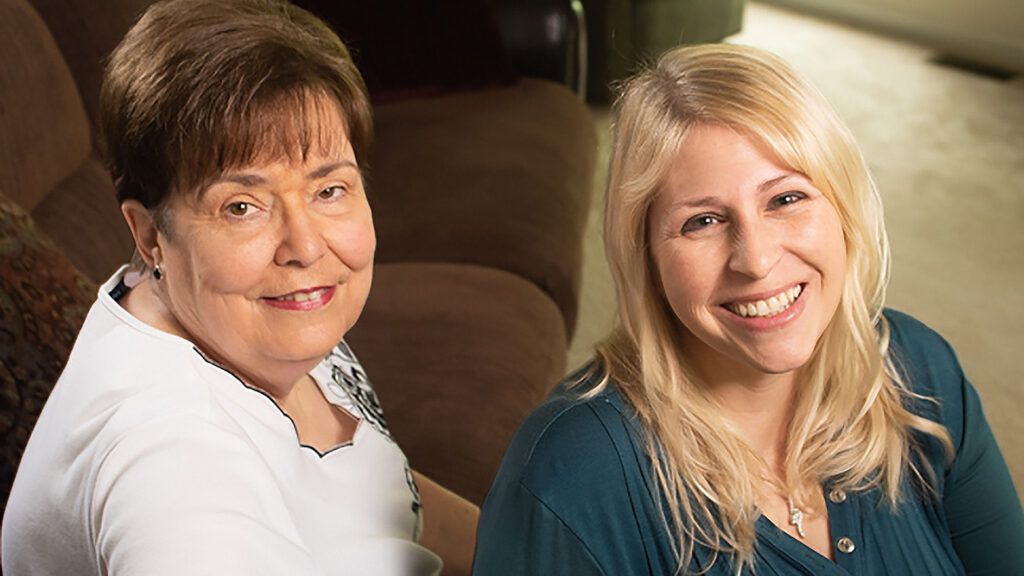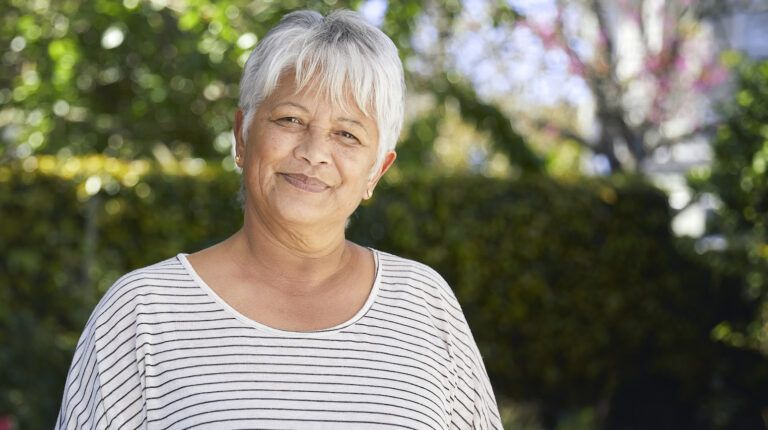I walked into my mother-in-law’s house, as always, without knocking. My father-in-law, Larry, had died months earlier, but part of me still expected to find him in his recliner in the living room, watching The Waltons on TV. “Hello,” I called out.
“I didn’t hear you come in,” Judy said, coming down the hallway from her bedroom. Not her real bedroom. Just the spare room she’d been sleeping in since Larry’s passing.
Larry and Judy had been married for 51 years. They’d had nine children; seven were still living. My husband, Eric, and I lived about a quarter mile away, so it was easy to pop in. But the past two years, ever since Larry had had several strokes, either Eric or I had been with Judy nearly constantly, helping with caregiving. His siblings had pitched in too. But with Larry gone—and despite my best intentions—it was sometimes days between visits.
I glanced at the kitchen table, where Judy’s Bible sat opened to a favorite verse. Next to it was a box of photos Eric had brought up from the basement the night Larry died. We’d looked through them as a family, choosing some to display at the funeral. Eric and I had both offered to take the box back to the basement, but Judy always shook her head.
She was only 73. I thought she would be okay on her own. Her quiet, can-do attitude had seen her through a lot over the years. I was sure she’d welcome the chance to get out of the house again whenever she wanted, to see friends or join a group at the senior center. But Judy hadn’t done any of that. It was as if she’d lost her joy in life, her grief compounded by loneliness. It broke my heart to see her like this.
“There are seven siblings and seven days in a week,” I told Eric that evening. He’s an engineer, so I knew he’d appreciate having a system. “Each sibling will take a day to call your mom or visit her. Then she won’t be lonely.”
“It’s a good idea,” Eric said. “But it’s not going to work. Everyone’s busy. If we could send her a text saying we’re thinking about her, the grandkids could get in on it too.”
“Yeah, well, that’s never going to happen either,” I said. With seven families and 13 teenagers or young adults among us, texting was our go-to way of communicating. When we were all caring for Larry, a family group text had been a lifesaver. That’s when Eric got Judy a smartphone, but she kept getting confused and forgetting the instructions. Eventually she gave the phone back and reverted to her old flip phone. She had no interest in texting.
“Whatever happened to using your phone for actually talking?” she’d say. I saw her point. There was no real reason we couldn’t call Judy to tell her something, other than that we’d all gotten used to a different way of communicating. The truth was, it was as hard for us to change back as it was for her to try something new.
Just as Eric predicted, my plan for a daily rotation never really got off the ground. Instead we went on communicating through text and e-mail, then had to remember to call Judy to keep her in the loop for any family get-together. If plans changed at the last minute, that meant another phone call. The bigger problem was that too often Judy missed the everyday chatter of our lives: the kids’ school projects, family snapshots, funny stories. Every few days I checked in on her, but it only reminded me how disconnected she was from friends and family, how lonely she probably was. I couldn’t fill her in on all the family news, but there had to be something I could do to involve her. Some way of convincing her not to be afraid of technology. I prayed about it but found no answers. Finally I gave up trying. Eric too.
Then Eric’s youngest sister, Cindy, announced her husband’s job had transferred him to Amsterdam. They’d be in the Netherlands for at least two years.
Days later, when Eric and I dropped by, Cindy’s move was all Judy could talk about. “We’re all going to have to get international calling plans,” she said. “Goodness knows what that costs.”
“It’s not the only way,” Eric said. “There are apps. Free ones.”
Judy stared at the floor. “I’ve never used an app.”
“I’ll be happy to teach you,” I offered.
“I’ll think about it,” she said. Not long after Cindy moved to Amsterdam, Eric’s older sister got a new job in Texas. It was evident how much Judy missed her daughters.
One day, she said, “What was that thing I can get on my phone that will help me talk to Cindy for free? I’m missing out on too much. I need to be more connected.”
I could hardly believe it. The very thing I’d prayed for!
Another of Eric’s sisters bought Judy a less complicated smartphone. Eric downloaded the WhatsApp messaging app for her. Moments later she was talking to Cindy, the reception crystal clear. Judy couldn’t stop smiling.
When the call was over, Eric showed her how she could text using the app and even video-chat. At first, she used it only if one of us was there to help her. Then one day I took her to lunch.
“One of my friends uses WhatsApp,” she said. “She texts her grandkids with it. I think I might like to do that too.”
“That’s great,” I said, resisting the urge to push further. In God’s time, I reminded myself. Judy had grown more active socially too, joining a Bible study and going to lunch with friends.
A few days later, my phone pinged with a text. “Hi,” it read. Judy!
“You sent me a text,” I typed back.
“I sent one to everyone in my contact list!” Nothing could hold Judy back after that. With the press of a key, she had someone to pass the time with—a connection that didn’t replace a face-to- face meeting yet offered an intimacy all its own.
Soon Judy wanted to tackle the laptop computer we kids had bought her for Christmas several years before. “There’s this pastor I like,” she said. “He sends out newsletters on e-mail. I’d like to subscribe.”
Eric set up an e-mail address for her and showed her how to find the pastor’s website. On her own, Judy e-mailed a contractor about a home improvement project. A granddaughter taught her how to look for recipes on Pinterest. She’s excited to learn how to shop online.
But her first love is still messaging. Staying in the loop with children and grandchildren, friends from church. Laughing at jokes. Sharing recipes. Extending birthday greetings or congratulations on a good report card. Sometimes it feels as if Judy is more in the loop than I am. And today when I visit her—still without knocking—I see a different woman. Happier. No longer lonely. She’s back in her real bedroom, and the box of photos has been returned to a shelf in the basement. (Her old Bible is still front and center.)
Loneliness is one of our society’s greatest problems. And when your family member is suffering, the problem really hits home. Yet all my attempts to make Judy change failed. Only God could do that.
Our immediate solution was the technology we’ve all come to depend on. But the real breakthrough was helping my mother-in-law reconnect with her family and friends, with her life.
Read more: 5 Ways to Be a Better Listener
For more inspiring stories, subscribe to Guideposts magazine.






